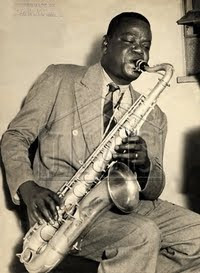Tem Sanfona no Choro
The accordion is a popular instrument in Brazil and is often closely associated with the Northeastern forró music, a sort of popular folk-music combining and mixing different European dance styles like the polka, mazurka, schottische, and quadrille a.o. with African rhythmic influence, traditionally performed by a forró trio with the accordion (- or as the instrument is named in Brazil: Sanfona) as melodic lead-voice, the triangel and the zabumba (bass) drum as supporting rhythmic accompaniment. An important figure in the evolvment of the forró and the spreading of the music to other parts of Brazil was the accordionist, vocalist, songwriter and composer Luiz Gonzaga.
Luiz Gonzaga do Nascimento, Sr.("Gonzagão", 1912-1989) was born in the countryside of Pernambuco as the son of a peasant and accordion player. As a child he was soon attracted by music and the accordion, he accompanied his father by playing the zabumba and singing at parties and religious celebrations.In 1930 he left home to join the army and toured Brazil with an army band until 1939. Gonzaga then decided to remain in Rio de Janeiro with a recently purchased accordion. He used to perform popular music of the time in the streets and in bars, and after noticing that the Northeastern immigrants missed the music from their hometowns, he started to play the kind of music he knew well from his younger days in Pernambuco. At a talent-show he played examples of this Northeastern music and was acclaimed by the audience and won the contest.After discovering this niche in the market, Gonzaga became a regular at radio shows and started making records. In 1943, he dressed up in typical Northeastern costumes for the first time to perform live, and got hyped. Later on, as well as playing popular tunes on the accordion, he began to sing his own material. His greatest hit ever, "Asa Branca" (written with Humberto Teixeira), was recorded in 1947 and covered countless times by many different artists.
Gonzaga worked on the radio until 1954, enjoying huge popularity. He is widely recognized for singlehandedly taking the baião style and the accordion to a wide audience. Gonzaga is often mentioned as the King of baião, here's his prototype of the baião, a smash-hit of the late 1940s
During the 1960s, as the public taste shifted, Gonzaga found himself stranded from big city stages, so he toured the countryside, where his popularity never abated. In the 1970s and 1980s, he slowly re-emerged, partly due to covers of his songs by famous artists like Geraldo Vandré, Caetano Veloso, Gilberto Gil, his son Gonzaguinha and Milton Nascimento. - In 2012 the Centennial of Luiz Gonzaga was celebrated all over Brazil through new recordings, events and concerts by contemporary artists, records by the master himself were reissued and his music was studied and appreciated by a new generation. Among the many activities paying homage to the importance of Luiz Gonzaga in
Brazilian popular music, I like to point you to a recently released CD that celebrates Gonzaga's contributions to choro, a music genre and style he knew well and also excelled in during his early career in the 1940s.
The CD is recorded by Marcelo Caldi (b 1980, Rio de Janeiro), a musician, composer, accordionist, pianist, arranger, orchestrator and Brazilian singer, who has released several CDs already documenting a wide range of different music influence from the Argentine tango to choral works. As an instrumentalist and vocalist Marcelo Caldi has recorded and performed in a family trio named Libertango, and his work as an accordionist in the forró and choro style was documented in the CD 'Forró e Choro Vol. 1' (2009, together with reed player Fábio Luna). The shown CD 'Tem Sanfona no Choro' (2012) continues to set focus on Marcelo Caldi's involvement with the accordion and
is solely dedicated to the music of Luiz Gonzaga showing off Gonzaga's early works in choro and related styles. The recorded music has also been transribed in a recently published book by Marcelo Caldi released by the Instituto Moreira Salles together with the accompanying cd, available for purchase here . - The music CD alone is available for purchase as mp3 download from Amazon and other online providers. You may learn more about Marcelo Caldi's career from his official web (- in Portuguese only).
The shown CD contains thirteen tracks of delightful and most enjoyable accordion music, Marcelo Caldi has the lead-voice throughout and is accompanied by a rhythm section consisting of bandolim or cavaco, violão 7 cordas and percussion, one of the tracks have piano overdub and another has alto sax added as second lead. To give you an impression of Marcelo Caldi's renditions of Gonzaga's works in the choro style, I'll insert a couple of videos uploaded at YouTube presenting some of the music at the 'Tem Sanfona no Choro' cd. - Here's first Marcelo Caldi performing Gonzaga's choro "Pisa de Mansinho", Caldi is accompanied by Nando Duarte (violão 7 cordas) and Fabiano Salek (percussion) from a presentation at Sala Funarte Sidney Müller, Rio de Janeiro, February 2012
From the same performance, here's a reading of Gonzaga's "Araponga"
From a presentation earlier this year, Marcelo Caldi performed as lead artist together with Conjunto Época de Ouro also at the Sala Funarte Sidney Müller, Rio de Janeiro, one of the tunes played and uploaded at YouTube was Gonzaga's "Sanfonando", also available on the CD. Enjoy!
---
Jo







1 Comments:
Thanks Jo for this great post!
Post a Comment
<< Home